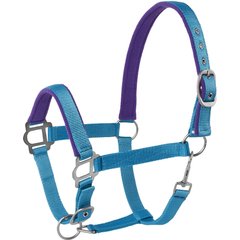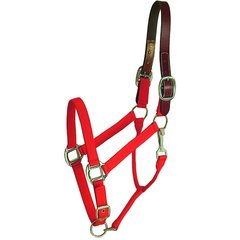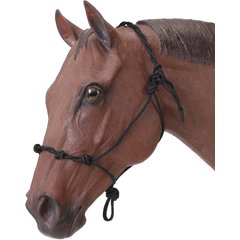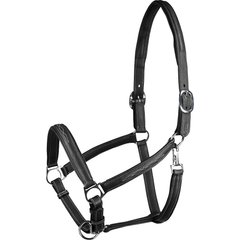Your Complete Guide to Horse Halters
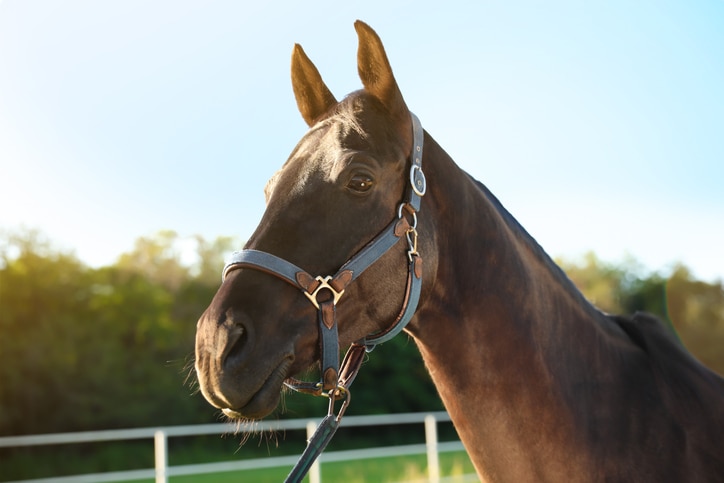
Photo by Liudmila Chernetska/iStock / Getty Images Plus via Getty Images
Horse halters are one piece of tack you’ll use every day—maybe multiple times a day! But with so many halter styles and sizes available, where does one begin?
In this guide, you’ll find tips for selecting the right halter for your horse.
Why Horse Halters Are Important
You’ll need a halter to lead and tie your horse, load him on the trailer, hold him for the farrier or veterinarian, and lunge or participate in other groundwork activities.
Choosing a halter that properly fits your horse for his safety and comfort is essential. A halter that is too tight can pinch and cause sore spots. A halter that is too large can slip off your horse unexpectedly. Finding the proper halter to suit your horse is like choosing a new pair of shoes—some styles and materials may work better for you than others.
Types of Horse Halters
Horse halters are made from a variety of materials. Here’s a look at the choices you have for your horse.
Leather Horse Halters
Leather horse halters are a versatile option that can be used daily or at horse shows. Good-quality leather is durable for regular use but it can break under pressure if a horse panics, becomes trapped, or tangled. Some horse boarding facilities may even require you to have a leather halter for your horse’s everyday use.
Leather is more expensive than other materials, but its safety features and horse comfort make it a popular choice. Leather halters typically feature adjustable crownpieces and chin straps.
With proper care, regular cleaning, and oiling, a leather halter can last for years. It’s also easy to customize with a brass nameplate engraved with your horse’s name!
Recommended Product
Nylon Horse Halters
Halters made from flat nylon webbing are popular because they are budget-friendly and available in a wide variety of colors and patterns. Like leather halters, nylon halters include multiple adjustment options to ensure a good fit.
One thing to consider is that nylon does not break under pressure. So if a horse is in an emergency, the halter won’t break and increase the risk or severity of injury.
Recommended Product
Breakaway Horse Halters
Breakaway horse halters are typically made of nylon, but with a leather crownpiece that will break in an emergency. These halters are sturdy enough to secure horses for tying but will snap if the horse panics or becomes caught or trapped.
Because the leather crownpieces buckle on both sides of the halter, it is easy to repair and reuse a breakaway horse halter.
Recommended Product
Horse Rope Halters
Rope halters are made from braided polyester, nylon, or cotton rope. The rope may be stiff or more flexible depending on the material used. The stiffness factors into the amount of pressure the rope applies to the horse’s face.
Rather than buckles or straps, knots give a rope halter its shape. Because there are no buckles or snaps, you must know how to properly tie a rope halter to secure it to your horse’s head and avoid the excess from getting in his eyes. Even though the materials do not break, horses wearing rope halters should still never be left unattended.
Rope halters are often considered training halters. However, not all trainers agree on their use because the knots across the horse’s nose apply pressure on sensitive areas of the horse’s nose and cheeks, creating negative reinforcement.
Recommended Product
Horse Show Halters
Show halters are designed to enhance your horse’s appearance in the show ring. Western show halters might include engraved silver enhancements on the cheek pieces or fancy hand-tooled designs carved into the leather.
English-style show halters are more traditional and lack the embellishments seen on Western halters. They are made from high-quality leather and may feature additional stitching. Either discipline might include a horse’s nameplate on the cheekpieces.
Recommended Product
What To Look for in a Horse Halter
Before buying a halter for your horse, consider how you’ll be using it. Ask yourself:
- Will the halter be used for one horse or multiple horses in your barn?
- Are you shopping on a budget?
- When will the horse wear the halter (At shows? During turnout?)
Generally, it is not recommended that horses wear halters during turnout. A horse could catch a leg in the halter, and halters can also easily snag on trees, fence posts, and other hazards. If the horse can’t free himself, a severe injury or even death is possible.
However, there are times when horses are turned out with halters. For example, some horses are escape artists and a halter makes it easier to catch them. Whenever horses are turned out wearing a halter, use a breakaway halter for safety.
Horse Halter Sizes: How Do You Choose?
Halters come in various sizes designed to fit horses based on age, size, and breed. “Horse” is the average size used for most mature horses. However, horses with finer features like an Arabian may need a cob size, while larger working breeds need draft-size halters.
Horse halter sizes include:
- Foal (newborn)
- Weanling (approximately 6–12 months)
- Yearling (approximately 12–24 months)
- Pony: 200–300 pounds
- Miniature: 50–150 pounds
- Horse: 800–1,100 pounds
- Large horse: 1,100–1,600 pounds
- Arabian/Cob: 500–800 pounds
- Draft: 1,600–1,900 pounds
Horse Halter Measuring
Ideally, you want a halter that can be adjusted to fit snugly against the horse’s nose and cheek without pinching.
Halter measurements are based on the circumference of your horse’s nose and head. You’ll also want to measure the length between the spot where the halter sits behind your horse’s ears and the back of his nose. Use a seamstress or flexible measuring tape to take your horse’s measurements.
3 Steps for a Proper Horse Halter Fit
Regardless of the halter size you buy, it will likely need adjusting. Use these three simple steps to properly fit the halter to your horse.
- Adjust the crownpiece to the middle hole and place it on your horse’s head to determine if further adjustment is needed. If the halter has two buckles, use the same on both sides for a symmetrical fit. The crownpiece should sit just behind your horse’s ears.
- When adjusted properly, the noseband should sit about two inches below the bony point of the cheek. If it falls too high, loosen the crownpiece one notch at a time. If it is too low, raise the crownpiece up a notch.
- If the halter has an adjustable chin strap, loosen or tighten the strap until it’s snug but you can still fit in a finger or two (about two inches). This helps to avoid over-tightening.
How To Put a Halter on a Horse
Haltering your horse should be an easy task if he is well-mannered and has proper training. Before approaching your horse, ensure the halter is unbuckled or untied so you can easily slip it over his nose.
- When haltering your horse in the pasture, approach from his left side carrying the halter in your left hand. This position makes it easy to guide the noseband over your horse’s nose and leaves your right hand free to tie a rope halter or secure buckles and snaps.
- If your horse is easy to catch, you can slip the noseband over his nose and pull the crownpiece up toward his ears and over his head.
- Gently slide each ear under the crownpiece.
- If your horse is head shy, moves, or walks away from you, loop the lead rope over his neck and hold both ends in your right hand. Then follow the same process as described above.
This content was medically reviewed by Jennifer Rice, DVM, CVSMT, Chewy veterinarian.

